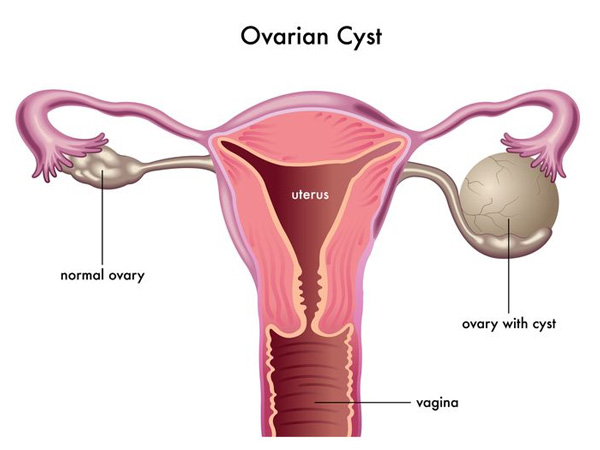
Most women will experience a cyst on the ovaries at least once, and most are painless, cause no symptoms, and are discovered during a routine pelvic exam. Symptoms of an ovarian cyst include nausea, vomiting, bloating, painful bowel movements, and pain during sex.
In rare cases, an ovarian cyst can cause serious problems, so it’s best to have it checked by your doctor. The ovaries are part of the female reproductive system. They’re located in the lower abdomen on both sides of the uterus. Women have two ovaries that produce eggs as well as the hormones estrogen and progesterone.
Sometimes, a fluid-filled sac called a cyst will develop on one of the ovaries. Many women will develop at least one cyst during their lifetime. In most cases, cysts are painless and cause no symptoms.
There are various types of ovarian cysts, such as dermoid cysts and endometrioma cysts. However, functional cysts are the most common type. The two types of functional cysts include follicle and corpus luteum cysts.
During a woman’s menstrual cycle, an egg grows in a sac called a follicle. This sac is located inside the ovaries. In most cases, this follicle or sac breaks open and releases an egg. But if the follicle doesn’t break open, the fluid inside the follicle can form a cyst on the ovary.
Follicle sacs typically dissolve after releasing an egg. But if the sac doesn’t dissolve and the opening of the follicle seals, additional fluid can develop inside the sac, and this accumulation of fluid causes a corpus luteum cyst.
These symptoms can indicate a ruptured cyst or an ovarian torsion. Both complications can have serious consequences if not treated early.
Most ovarian cysts are benign and naturally go away on their own without treatment. These cysts cause little, if any, symptoms. But in a rare case, your doctor may detect a cancerous cystic ovarian massduring a routine examination. Ovarian torsion is another rare complication of ovarian cysts. This is when a large cyst causes an ovary to twist or move from its original position. Blood supply to the ovary is cut off, and if not treated, it can cause damage or death to the ovarian tissue. Although uncommon, ovarian torsion accounts for nearly 3 percent of emergency gynecologic surgeries.
Ruptured cysts, which are also rare, can cause intense pain and internal bleeding. This complication increases your risk of an infection and can be life-threatening if left untreated.
Your doctor can detect an ovarian cyst during a routine pelvic examination. They may notice swelling on one of your ovaries and order an ultrasound test to confirm the presence of a cyst. An ultrasound test (ultrasonography) is an imaging test that uses high-frequency sound waves to produce an image of your internal organs. Ultrasound tests help determine the size, location, shape, and composition (solid or fluid filled) of a cyst.
CT scan: a body imaging device used to create cross-sectional images of internal organs
MRI: a test that uses magnetic fields to produce in-depth images of internal organs
Ultrasound device: an imaging device used to visualize the ovary
Because the majority of cysts disappear after a few weeks or months, your doctor may not immediately recommend a
treatment plan. Instead, they may repeat the ultrasound test in a few weeks or months to check your condition.
If there aren’t any changes in your condition or if the cyst increases in size, your doctor will request additional tests to determine other causes of your symptoms.
pregnancy test to make sure you’re not pregnant
Hormone level test to check for hormone-related issues, such as too much estrogen or progesterone
CA-125 blood test to screen for ovarian cancer
Your doctor may recommend treatment to shrink or remove the cyst if it doesn’t go away on its own or if it grows larger.
If you have recurrent ovarian cysts, your doctor can prescribe oral contraceptives to stop ovulation and prevent the development of new cysts. Oral contraceptives can also reduce your risk of ovarian cancer. The risk of ovarian cancer is higher in postmenopausal women.
If your cyst is small and results from an imaging test to rule out cancer, your doctor can perform a laparoscopy to surgically remove the cyst. The procedure involves your doctor making a tiny incision near your navel and then inserting a small instrument into your abdomen to remove the cyst.
If you have a large cyst, your doctor can surgically remove the cyst through a large incision in your abdomen. They’ll conduct an immediate biopsy, and if they determine that the cyst is cancerous, they may perform a hysterectomy to remove your ovaries and uterus.
Ovarian cysts can’t be prevented. However, routine gynecologic examinations can detect ovarian cysts early. Benign ovarian cysts don’t become cancerous. However, symptoms of ovarian cancer can mimic symptoms of an ovarian cyst. Thus, it’s important to visit your doctor and receive a correct diagnosis. Alert your doctor to symptoms that may indicate a problem, such as:
changes in your menstrual cycle
Ongoing pelvic pain
Loss of appetite
Unexplained weight loss
Abdominal fullness
The outlook for premenopausal women with ovarian cysts is good. Most cysts disappear within a few months. However, recurrent ovarian cysts can occur in premenopausal women and women with hormone imbalances. If left untreated, some cysts can decrease fertility. This is common with endometriomas and polycystic ovary syndrome. To improve fertility, your doctor can remove or shrink the cyst. Functional cysts, cystadenomas, and dermoid cysts do not affect fertility.
Although some doctors take a “wait and see” approach with ovarian cysts, your doctor may recommend surgery to remove and examine any cyst or growth that develops on the ovaries after menopause. This is because the risk of developing a cancerous cyst or ovarian cancer increases after menopause. However, ovarian cysts don’t increase the risk of ovarian cancer. Some doctors will remove a cyst if it’s larger than 5 centimeters in diameter.